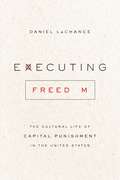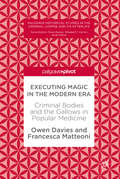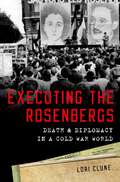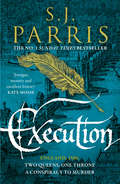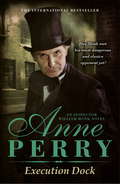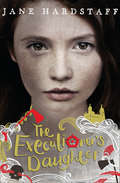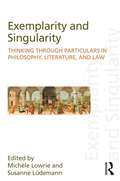- Table View
- List View
Executing Freedom: The Cultural Life of Capital Punishment in the United States
by Daniel LaChanceIn the mid-1990s, as public trust in big government was near an all-time low, 80% of Americans told Gallup that they supported the death penalty. Why did people who didn’t trust government to regulate the economy or provide daily services nonetheless believe that it should have the power to put its citizens to death? That question is at the heart of Executing Freedom, a powerful, wide-ranging examination of the place of the death penalty in American culture and how it has changed over the years. Drawing on an array of sources, including congressional hearings and campaign speeches, true crime classics like In Cold Blood, and films like Dead Man Walking, Daniel LaChance shows how attitudes toward the death penalty have reflected broader shifts in Americans’ thinking about the relationship between the individual and the state. Emerging from the height of 1970s disillusion, the simplicity and moral power of the death penalty became a potent symbol for many Americans of what government could do—and LaChance argues, fascinatingly, that it’s the very failure of capital punishment to live up to that mythology that could prove its eventual undoing in the United States.
Executing Freedom: The Cultural Life of Capital Punishment in the United States
by Daniel LaChanceIn the mid-1990s, as public trust in big government was near an all-time low, 80% of Americans told Gallup that they supported the death penalty. Why did people who didn’t trust government to regulate the economy or provide daily services nonetheless believe that it should have the power to put its citizens to death? That question is at the heart of Executing Freedom, a powerful, wide-ranging examination of the place of the death penalty in American culture and how it has changed over the years. Drawing on an array of sources, including congressional hearings and campaign speeches, true crime classics like In Cold Blood, and films like Dead Man Walking, Daniel LaChance shows how attitudes toward the death penalty have reflected broader shifts in Americans’ thinking about the relationship between the individual and the state. Emerging from the height of 1970s disillusion, the simplicity and moral power of the death penalty became a potent symbol for many Americans of what government could do—and LaChance argues, fascinatingly, that it’s the very failure of capital punishment to live up to that mythology that could prove its eventual undoing in the United States.
Executing Freedom: The Cultural Life of Capital Punishment in the United States
by Daniel LaChanceIn the mid-1990s, as public trust in big government was near an all-time low, 80% of Americans told Gallup that they supported the death penalty. Why did people who didn’t trust government to regulate the economy or provide daily services nonetheless believe that it should have the power to put its citizens to death? That question is at the heart of Executing Freedom, a powerful, wide-ranging examination of the place of the death penalty in American culture and how it has changed over the years. Drawing on an array of sources, including congressional hearings and campaign speeches, true crime classics like In Cold Blood, and films like Dead Man Walking, Daniel LaChance shows how attitudes toward the death penalty have reflected broader shifts in Americans’ thinking about the relationship between the individual and the state. Emerging from the height of 1970s disillusion, the simplicity and moral power of the death penalty became a potent symbol for many Americans of what government could do—and LaChance argues, fascinatingly, that it’s the very failure of capital punishment to live up to that mythology that could prove its eventual undoing in the United States.
Executing Magic in the Modern Era: Criminal Bodies and the Gallows in Popular Medicine
by Owen Davies Francesca MatteoniThis book is open access under a CC BY 4.0 licenseThis book explores the magical and medical history of executions from the eighteenth to the early twentieth century by looking at the afterlife potency of criminal corpses, the healing activities of the executioner, and the magic of the gallows site. The use of corpses in medicine and magic has been recorded back into antiquity. The lacerated bodies of Roman gladiators were used as a source of curative blood, for instance. In early modern Europe, a great trade opened up in ancient Egyptian mummies and the fat of executed criminals, plundered as medicinal cure-alls. However, this is the first book to consider the demand for the blood of the executed, the desire for human fat, the resort to the hanged man’s hand, and the trade in hanging rope in the modern era. It ends by look at the spiritual afterlife of dead criminals.
Executing Magic in the Modern Era: Criminal Bodies and the Gallows in Popular Medicine
by Owen Davies Francesca MatteoniThis book is open access under a CC BY 4.0 licenseThis book explores the magical and medical history of executions from the eighteenth to the early twentieth century by looking at the afterlife potency of criminal corpses, the healing activities of the executioner, and the magic of the gallows site. The use of corpses in medicine and magic has been recorded back into antiquity. The lacerated bodies of Roman gladiators were used as a source of curative blood, for instance. In early modern Europe, a great trade opened up in ancient Egyptian mummies and the fat of executed criminals, plundered as medicinal cure-alls. However, this is the first book to consider the demand for the blood of the executed, the desire for human fat, the resort to the hanged man’s hand, and the trade in hanging rope in the modern era. It ends by look at the spiritual afterlife of dead criminals.
Executing the Rosenbergs: Death and Diplomacy in a Cold War World
by Lori CluneIn 1950, Julius and Ethel Rosenberg were arrested for allegedly passing information about the atomic bomb to the Soviet Union, an affair FBI Director J. Edgar Hoover labeled the "crime of the century." Their case became an international sensation, inspiring petitions, letters of support, newspaper editorials, and protests in countries around the world. Nevertheless, the Rosenbergs were executed after years of appeals, making them the only civilians ever put to death for conspiracy-related activities. Yet even after their executions, protests continued. The Rosenberg case quickly transformed into legend, while the media spotlight shifted to their two orphaned sons. In Executing the Rosenbergs, Lori Clune demonstrates that the Rosenberg case played a pivotal role in the world's perception of the United States. Based on newly discovered documents from the State Department, Clune narrates the widespread dissent against the Rosenberg decision in 80 cities and 48 countries. Even as the Truman and Eisenhower administrations attempted to turn the case into pro-democracy propaganda, U.S. allies and potential allies questioned whether the United States had the moral authority to win the Cold War. Meanwhile, the death of Stalin in 1953 also raised the stakes of the executions; without a clear hero and villain, the struggle between democracy and communism shifted into morally ambiguous terrain. Transcending questions of guilt or innocence, Clune weaves the case -and its aftermath -into the fabric of the Cold War, revealing its far-reaching global effects. An original approach to one of the most fascinating episodes in Cold War history, Executing the Rosenbergs broadens a quintessentially American story into a global one.
Executing the Rosenbergs: Death and Diplomacy in a Cold War World
by Lori CluneIn 1950, Julius and Ethel Rosenberg were arrested for allegedly passing information about the atomic bomb to the Soviet Union, an affair FBI Director J. Edgar Hoover labeled the "crime of the century." Their case became an international sensation, inspiring petitions, letters of support, newspaper editorials, and protests in countries around the world. Nevertheless, the Rosenbergs were executed after years of appeals, making them the only civilians ever put to death for conspiracy-related activities. Yet even after their executions, protests continued. The Rosenberg case quickly transformed into legend, while the media spotlight shifted to their two orphaned sons. In Executing the Rosenbergs, Lori Clune demonstrates that the Rosenberg case played a pivotal role in the world's perception of the United States. Based on newly discovered documents from the State Department, Clune narrates the widespread dissent against the Rosenberg decision in 80 cities and 48 countries. Even as the Truman and Eisenhower administrations attempted to turn the case into pro-democracy propaganda, U.S. allies and potential allies questioned whether the United States had the moral authority to win the Cold War. Meanwhile, the death of Stalin in 1953 also raised the stakes of the executions; without a clear hero and villain, the struggle between democracy and communism shifted into morally ambiguous terrain. Transcending questions of guilt or innocence, Clune weaves the case -and its aftermath -into the fabric of the Cold War, revealing its far-reaching global effects. An original approach to one of the most fascinating episodes in Cold War history, Executing the Rosenbergs broadens a quintessentially American story into a global one.
Execution: A Giordano Bruno Thriller (Giordano Bruno #6)
by S. J. ParrisThe No. 1 Sunday Times bestselling series, perfect for fans of C. J. Sansom and The Mirror and the Light by Hilary Mantel The new book in S. J. Parris’s bestselling, critically acclaimed series following Giordano Bruno, set at the time of Queen Elizabeth I
Execution: A History of Capital Punishment in Britain
by Simon WebbJudicial hanging is regarded by many as being the quintessentially British execution. However, many other methods of capital punishment have been used in this country; ranging from burning, beheading and shooting to crushing and boiling to death. This book explores these types of execution in detail. Readers may be surprised to learn that a means of mechanical decapitation, the Halifax Gibbet, was being used in England five hundred years before the guillotine was invented. Boiling to death was a prescribed means of execution in this country during the Tudor period. From the public death by starvation of those gibbeted alive, to the burning of women for petit treason, this book examines some of the most gruesome passages of British history.
Execution Dock: A gripping Victorian mystery of corruption, betrayal and intrigue (William Monk Mystery #16)
by Anne PerryHas Monk met his most dangerous and elusive opponent yet? The death of a young boy leads Monk into one of his most dangerous cases yet in the sixteenth book in Anne Perry's brilliant William Monk series Execution Dock. Perfect for fans of C. J. Sansom and Arthur Conan Doyle.'Rich in plot development, believable characters and period detail, this entry will only add to the already sizable ranks of Perry's admirers' - Publishers Weekly It's 1864, and after a game of cat and mouse, Monk has captured Jericho Phillips, the man he suspects of brutally killing a young mudlark and running an evil child prostitution ring. In bringing Phillips to justice, Monk hopes to close down the ring and avenge the memory of Durban, his old commander, who was determined to capture Philips. However, at trial justice does not prevail. Oliver Rathbone, Monk's friend, is hired anonymously to represent the accused and when he proves that vital evidence is missing, Phillips is freed. As Monk begins the investigation again, venturing deeper into London's murky underworld, he realises that Durban may have had his own reasons for pursuing Phillips, and shockingly, that secret support for Phillips may reach further into civilised society than anyone could ever have imagined... What readers are saying about Execution Dock: 'Ms Perry's books inform, entertain, and make me think...what more can a reader ask for?''[A] compelling, assiduously plotted story''Well written with a gripping story line... You really feel the dirt and squalor of Victorian London'
The Execution of Admiral John Byng as a Microhistory of Eighteenth-Century Britain
by Joseph J. KrulderAccording to Voltaire's Candide, Admiral John Byng's 1757 execution went forward to 'encourage the others'. Of course, the story is more complicated. This microhistorical account upon a macro-event presents an updated, revisionist, and detailed account of a dark chapter in British naval history. Asking 'what was Britain like the moment Byng returned to Portsmouth after the Battle of Minorca (1756)?' not only returns a glimpse of mid-eighteenth century Britain but provides a deeper understanding of how a wartime admiral, the son of a peer, of some wealth, a once colonial governor, and sitting member of parliament came to be scapegoated and then executed for the failings of others. This manuscript presents a cultural, social, and political dive into Britain at the beginning of the Seven Years' War. Part 1 focuses on ballad, newspaper, and prize culture. Part 2 makes a turn towards the social where religion, morality, rioting, and disease play into the Byng saga. Admiral Byng's record during the 1755 Channel Campaign is explored, as is the Mediterranean context of the Seven Years' War, troubles elsewhere in the empire, and then the politics behind Byng's trial and execution.
The Execution of Admiral John Byng as a Microhistory of Eighteenth-Century Britain
by Joseph J. KrulderAccording to Voltaire's Candide, Admiral John Byng's 1757 execution went forward to 'encourage the others'. Of course, the story is more complicated. This microhistorical account upon a macro-event presents an updated, revisionist, and detailed account of a dark chapter in British naval history. Asking 'what was Britain like the moment Byng returned to Portsmouth after the Battle of Minorca (1756)?' not only returns a glimpse of mid-eighteenth century Britain but provides a deeper understanding of how a wartime admiral, the son of a peer, of some wealth, a once colonial governor, and sitting member of parliament came to be scapegoated and then executed for the failings of others. This manuscript presents a cultural, social, and political dive into Britain at the beginning of the Seven Years' War. Part 1 focuses on ballad, newspaper, and prize culture. Part 2 makes a turn towards the social where religion, morality, rioting, and disease play into the Byng saga. Admiral Byng's record during the 1755 Channel Campaign is explored, as is the Mediterranean context of the Seven Years' War, troubles elsewhere in the empire, and then the politics behind Byng's trial and execution.
The Executioner of St Paul's: The Twelfth Thomas Chaloner Adventure (Adventures of Thomas Chaloner)
by Susanna GregoryThe twelfth adventure in the Thomas Chaloner series. The plague raging through London in 1665 has emptied the city. The only people left are those too poor to flee, or those who selflessly struggle to control the contagion and safeguard the capital's future.Amongst them, though, are those prepared to risk their health for money - those who sell dubious 'cures' and hawk food at wildly inflated prices. Also amongst them are those who hold in their hands the future of the city's most iconic building - St Paul's Cathedral.The handsome edifice is crumbling from decades of neglect and indecision, giving the current custodians a stark choice - repair or demolish. Both sides have fanatical adherents who have been fighting each other since the Civil Wars. Large sums of money have disappeared, major players have mysteriously vanished, and then a unidentified skeleton is discovered in another man's grave.A reluctant Chaloner returns to London to investigate, only to discover that someone is determined to thwart him by any means - by bullet, poison or bludgeon - and he fears he has very little time to identify the culprits before he becomes yet another victim in the battle for the Cathedral's future.'Pungent with historical detail' (Irish Times)'A richly imagined world of colourful medieval society and irresistible monkish sleuthing' (Good Book Guide) 'Corpses a-plenty, exciting action sequences and a satisfying ending' (Mystery People)
The Executioner's Daughter (Executioner's Daughter)
by Jane HardstaffA thrilling adventure set in the underbelly of the Tower of London. Perfect for fans of Philippa Gregory's 'Order of Darkness' series and Percy Jackson.
Executive Governance in Israel (Advances in Political Science)
by A. Arian D. Nachmias R. AmirThis is the first comprehensive examination of the evolution of executive governance in Israel. The book describes and analyzes the political and bureaucratic structures and processes that led to the predominance of the executive in policymaking and governance. It also analyzes recent political and administrative reforms and their consequences on the Knesset, political parties, governing coalitions and non-elected public authorities.
Executive Politics in Times of Crisis (Executive Politics and Governance)
by Martin Lodge and Kai WegrichExecutive Politics in Times of Crisis brings together leading international scholars to consider key trends and challenges that have defined executive politics over the past decade. It showcases key debates in executive politics and contributes to an understanding of the 'executive factor' in political life.
The Executive Way: Conflict Management in Corporations (Chicago History Of American Civilization Ser.)
by Calvin MorrillWhat causes conflict among high-level American corporate executives? How do executives manage their conflicts? Based on candid interviews with over two hundred executives and their support personnel, Calvin Morrill provides an intimate portrait of these men and women as they cope with problems usually hidden from those outside their exclusive ranks. Personal and corporate scandals, compensation battles, budget worries, interdepartmental rivalries, personal enmities, and general rancor are among everyday challenges faced by executives. Morrill shows what most influences the way managers handle routine conflicts are the cultures created by their company's organizational structure: whether there is a strong hierarchy, a weak hierarchy, or an absence of any strong central authority. The issues most likely to cause conflict within corporations Morrill identifies as managerial style, competition between departments, and performance evaluations, promotions, and compensation. Among the people whose day-to-day lives we get to know are Jacobs, a divisional executive whose intuitive understanding of the corporate hierarchy enables him to topple his incompetent superior without direct confrontation; Fuller, who through a mix of brains, guile, and connections rises from staff executive secretary to corporate vice president in a large bank; Green, an old-fashioned accounting partner in a firm being taken over by management consultants; and the "Princess of Power," "Iron Man," and the "Terminator"—executives fighting their way to the top of a successful entertainment company. Unprecedented in its direct access to top managers, this portrayal of daily life and conflict management among corporate elites will be of interest to professionals, scholars, and practitioners in organizational culture and behavior, managerial decision making, dispute, social control, law and society, and organizational ethnography.
Exemplarity and Singularity: Thinking through Particulars in Philosophy, Literature, and Law
by Susanne Lüdemann Michele LowrieThis book pursues a strand in the history of thought – ranging from codified statutes to looser social expectations – that uses particulars, more specifically examples, to produce norms. Much intellectual history takes ancient Greece as a point of departure. But the practice of exemplarity is historically rooted firmly in ancient Roman rhetoric, oratory, literature, and law – genres that also secured its transmission. Their pragmatic approach results in a conceptualization of politics, social organization, philosophy, and law that is derived from the concrete. It is commonly supposed that, with the shift from pre-modern to modern ways of thinking – as modern knowledge came to privilege abstraction over exempla, the general over the particular – exemplarity lost its way. This book reveals the limits of this understanding. Tracing the role of exemplarity from Rome through to its influence on the fields of literature, politics, philosophy, psychoanalysis and law, it shows how Roman exemplarity has subsisted, not only as a figure of thought, but also as an alternative way to organize and to transmit knowledge.
Exemplarity and Singularity: Thinking through Particulars in Philosophy, Literature, and Law
by Susanne Lüdemann Michèle LowrieThis book pursues a strand in the history of thought – ranging from codified statutes to looser social expectations – that uses particulars, more specifically examples, to produce norms. Much intellectual history takes ancient Greece as a point of departure. But the practice of exemplarity is historically rooted firmly in ancient Roman rhetoric, oratory, literature, and law – genres that also secured its transmission. Their pragmatic approach results in a conceptualization of politics, social organization, philosophy, and law that is derived from the concrete. It is commonly supposed that, with the shift from pre-modern to modern ways of thinking – as modern knowledge came to privilege abstraction over exempla, the general over the particular – exemplarity lost its way. This book reveals the limits of this understanding. Tracing the role of exemplarity from Rome through to its influence on the fields of literature, politics, philosophy, psychoanalysis and law, it shows how Roman exemplarity has subsisted, not only as a figure of thought, but also as an alternative way to organize and to transmit knowledge.
Exemplars of Kingship: Art, Tradition, and the Legacy of the Akkadians
by Melissa EppihimerStretching across the historical region of Mesopotamia, the Akkadian dynasty (ca. 2334-2154 BCE) created a territorial state of unprecedented scale in the ancient Near East by uniting the city-states of Sumer and Akkad and parts of Syria and Iran. To establish and, later, cement their authority over disparate peoples and places, the kings used art and visual culture to extraordinary effect. Exemplars of Kingship conveys the astonishing life of the art of the Akkadian kings by assessing ancient and modern responses to its dynamic forms and transformative ideologies of kingship. For nearly two thousand years after their reign, the Akkadian kings were remembered as exemplary rulers. Modern assessments of ancient memories of Akkadian kingship have concentrated on textual attestations of the kings' place in cultural memory. This book considers the contributions of images to memories of Akkadian kingship. Through close readings of the visuals that remain, Melissa Eppihimer discusses how Akkadian steles, statues, and cylinder seals became models for later rulers in Mesopotamia and beyond who wished to emulate or critique the Akkadian kings-and how these rulers and their contemporaries were reminded of the Akkadian past when they looked at images. Exemplars of Kingship is, therefore, a book about Akkadian art and its reception in antiquity, but it is also concerned with the modern reception of Akkadian art and kingship. It argues that modern responses have constrained our understanding of ancient responses. Through a wide range of examples drawn from almost two millennia, the book highlights the individual decisions that prompted continuity and change during the long history of Mesopotamia and its artistic traditions.
Exemplars of Kingship: Art, Tradition, and the Legacy of the Akkadians
by Melissa EppihimerStretching across the historical region of Mesopotamia, the Akkadian dynasty (ca. 2334-2154 BCE) created a territorial state of unprecedented scale in the ancient Near East by uniting the city-states of Sumer and Akkad and parts of Syria and Iran. To establish and, later, cement their authority over disparate peoples and places, the kings used art and visual culture to extraordinary effect. Exemplars of Kingship conveys the astonishing life of the art of the Akkadian kings by assessing ancient and modern responses to its dynamic forms and transformative ideologies of kingship. For nearly two thousand years after their reign, the Akkadian kings were remembered as exemplary rulers. Modern assessments of ancient memories of Akkadian kingship have concentrated on textual attestations of the kings' place in cultural memory. This book considers the contributions of images to memories of Akkadian kingship. Through close readings of the visuals that remain, Melissa Eppihimer discusses how Akkadian steles, statues, and cylinder seals became models for later rulers in Mesopotamia and beyond who wished to emulate or critique the Akkadian kings-and how these rulers and their contemporaries were reminded of the Akkadian past when they looked at images. Exemplars of Kingship is, therefore, a book about Akkadian art and its reception in antiquity, but it is also concerned with the modern reception of Akkadian art and kingship. It argues that modern responses have constrained our understanding of ancient responses. Through a wide range of examples drawn from almost two millennia, the book highlights the individual decisions that prompted continuity and change during the long history of Mesopotamia and its artistic traditions.
Exemplary Tales of Love and Tales of Disillusion (The Other Voice in Early Modern Europe)
by María de Zayas y SotomayorAt the height of María de Zayas’s popularity in the mid-eighteenth century, the number of editions in print of her work was exceeded only by the novels of Cervantes. But by the end of the nineteenth century, Zayas had been excluded from the Spanish literary canon because of her gender and the sociopolitical changes that swept Spain and Europe. Exemplary Tales of Love and Tales of Disillusion gathers a representative sample of seven stories, which features Zayas’s signature topics—gender equality and domestic violence—written in an impassioned tone overlaid with conservative Counter-Reformation ideology. This edition updates the scholarship since the most recent English translations, with a new introduction to Zayas’s entire body of stories, and restores Zayas’s author’s note and prologue, omitted from previous English-language editions. Tracing her slow but steady progress from notions of ideal love to love’s treachery, Exemplary Tales of Love and Tales of Disillusion will restore Zayas to her rightful place in modern letters.
Exemplary Tales of Love and Tales of Disillusion (The Other Voice in Early Modern Europe)
by María de Zayas y SotomayorAt the height of María de Zayas’s popularity in the mid-eighteenth century, the number of editions in print of her work was exceeded only by the novels of Cervantes. But by the end of the nineteenth century, Zayas had been excluded from the Spanish literary canon because of her gender and the sociopolitical changes that swept Spain and Europe. Exemplary Tales of Love and Tales of Disillusion gathers a representative sample of seven stories, which features Zayas’s signature topics—gender equality and domestic violence—written in an impassioned tone overlaid with conservative Counter-Reformation ideology. This edition updates the scholarship since the most recent English translations, with a new introduction to Zayas’s entire body of stories, and restores Zayas’s author’s note and prologue, omitted from previous English-language editions. Tracing her slow but steady progress from notions of ideal love to love’s treachery, Exemplary Tales of Love and Tales of Disillusion will restore Zayas to her rightful place in modern letters.
Exemplary Tales of Love and Tales of Disillusion (The Other Voice in Early Modern Europe)
by María de Zayas y SotomayorAt the height of María de Zayas’s popularity in the mid-eighteenth century, the number of editions in print of her work was exceeded only by the novels of Cervantes. But by the end of the nineteenth century, Zayas had been excluded from the Spanish literary canon because of her gender and the sociopolitical changes that swept Spain and Europe. Exemplary Tales of Love and Tales of Disillusion gathers a representative sample of seven stories, which features Zayas’s signature topics—gender equality and domestic violence—written in an impassioned tone overlaid with conservative Counter-Reformation ideology. This edition updates the scholarship since the most recent English translations, with a new introduction to Zayas’s entire body of stories, and restores Zayas’s author’s note and prologue, omitted from previous English-language editions. Tracing her slow but steady progress from notions of ideal love to love’s treachery, Exemplary Tales of Love and Tales of Disillusion will restore Zayas to her rightful place in modern letters.
Exemplary Traits: Reading Characterization in Roman Poetry
by J. Mira SeoHow did Roman poets create character? The mythological figures that dot the landscape of Roman poetry entail their own predetermined plotlines and received characteristics: the idea of a gentle, maternal Medea is as absurd as a spineless and weak Achilles. For Roman poets, the problem is even more acute since they follow on late in a highly developed literary tradition. The fictional characters that populate Roman literature, such as Aeneas and Oedipus, link text and reader in a form of communication that is strikingly different from a first person narrator to an addressee. With Exemplary Traits, Mira Seo addresses this often overlooked question. Her study offers an examination of how Roman poets used models dynamically to create character, and how their referential approach to character reveals them mobilizing the literary tradition. Close readings of Virgil, Lucan, Seneca, and Statius offer a more nuanced discussion of the expectations of both authors and audiences in the Roman world than those currently available in scholarly debate. By tracing the philosophical and rhetorical concepts that underlie the function of characterization, Exemplary Traits allows for a timely reconsideration of it as a fruitful literary technique.
